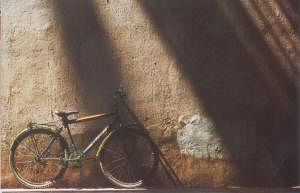Exhibition
One plus One
A show titled Two boldly puts disparate languages of art under one roof
Mustafa Zaman
Enamul Karim Nirjhar came to Dhaka to become a poet. Later he became hooked to the idea of seeing himself as an artist. However, he neither studied literature, nor fine arts. Instead he studied architecture. But there still remains a part in him that ventures out and strives to encapsulate the series of experiences, both visual and otherwise, through artistic means, namely, painting and photography. The recent show at the Gallery Shilpangan has brought into focus another aspect of this 30 plus architect. He arranged for a two-man show, where alongside his own photography another artist got to showcase a different mode of art. For the first time in his life, Roy Chand Shadhu gets the chance to unveil his talent for neatly crafted wood-block pieces to the art connoisseurs of Dhaka. He produced a series of low relief wood curving in this occasion. Shadhu and Nirjhar, at first reflection, may seem like an odd couple. The former, with his usual penchant for traditional craft, and the latter with the ability to focus his camera on segments of urban structures, mostly dilapidated ones, somehow complement each other. 'As an architect I work with all sort of craftspeople. At one point it occurred to me that craft is being pushed to a corner by the urbanites. So, I thought this show would be a chance to bring a rural form of art out in the open,' says Nirjhar standing amidst his works at the Shilpangan Gallery. Their show struck a different beat among the art buffs. As the show puts two disparate sensibilities, one of a polished urbanite and the other of a rural artisan, side by side, for any visitor it is a novel experience. Shadhu's acumen along with Nirjhar's formal representation of bleak yet exquisitely composed photographs is a combination that defies reason but provides a chance for the viewers to bask in their visual energy. 'The only reason for a joint exhibition is to demonstrate that craft is also art, and in the context of all the recent development it still retains its relevance in our life,' retorts Nirjhar when faced the question regarding his objective behind this show. Nirjhar's photographs are contextual in a sense,that as an architect he deals with concrete structures on a daily basis. His development as a photographer can easily be detected. He says, 'We are encased by walls, It was my intention to record them and present them in a very formal manner.' Alongside the formal urban images, Shadhu's story-telling works are pleasantly simplistic. They quench the thirst for narrative contents in the form of panoramic scene. They are tied to a Bengali tradition that goes back a long way. Shadhu becomes philosophical when faced with question of how his works connect with that of Nirjhar. To quote him, 'Village is a reality, so is the city. Therefore, the two modes of art that came out of these realities can also be presented side by side.' Shadhu has been churning out this kind of wood curving for last two years. Before that he was just another artisan who contributed towards the ornamentation of the interiors that Nirjhar used to design. At a restaurant called 'We' at Hampshire, England, Shadhu's wood panel provoked a lot of interest among the connoisseurs who took considerable interest in this traditional form of art. This set the duo on a course that resulted in this show. Shadhu testifies that Nirjhar is his mentor. But the artistic skill he applies is of a distinctly rural flavour, though the sparse use of the Moghul miniature-like tableau make Shadhu's story-based pieces look spectacular. The show took off on March 25 and will last till April 3, 2004.
|

A photograph by Enamul Karim Nirjhar |